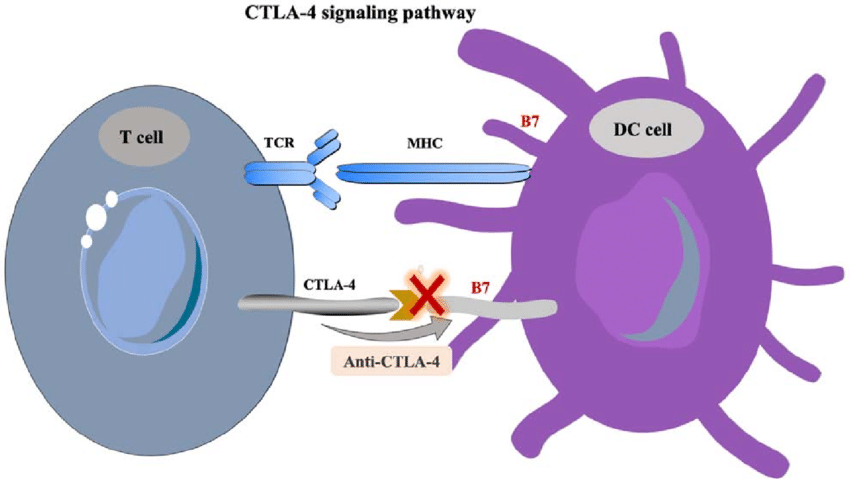What is CTLA4 Protein?
The Cytotoxic T-Lymphocyte Antigen 4 (CTLA4), a protein vital for sustaining an effective immune response.
Background and Discovery of CTLA4 Protein
CTLA4 protein is part of the immunoglobulin superfamily, thereby having a direct influence on the immune function. It was discovered in the early '90s, and since then, its role in immune regulation has significantly expanded our understanding of the immune system.
What Is The Structure of CTLA4 Protein?
Located on chromosome 2, in the region 2q33.2, the CTLA4 gene encodes this protein in humans. The encoded protein contains an extracellular V domain, a transmembrane domain, and a cytoplasmic tail. The structure of CTLA4 carries similarities with CD28, a well-known co-stimulatory molecule. Contrary to CD28, though, CTLA4 works in an inhibitory role and transmits an inhibitory signal to T cells—cells guarding our body against cancerous cells and pathogens.
What Is The Function of CTLA4 Protein?
The significant function of CTLA4 lies in its role in inhibitory signaling, which prevents overactivity of the immune system and protects the body against a potential autoimmune response. CTLA4 performs this function by outcompeting CD28 for binding with CD80 and CD86 on antigen-presenting cells (APCs), thereby switching off the stimulatory signal transmitted via CD28. Due to this role, CTLA4 is sometimes considered the "off switch" of the immune response.
CTLA4 protein related signal pathway
Further understanding of CTLA4's function comes through its role in the larger immune checkpoint signaling pathway. Briefly, the immune response begins with antigen presentation by APCs to the T-cell receptor (TCR). However, the bond formed between the TCR and the antigen is not solely sufficient to trigger a T-cell response. Another binding must occur between the CD28 on the T-cell surface and CD80/86 on the APC for an immune response to take place. CTLA4 interrupts this pathway by binding to CD80/86 more avidly than CD28, effectively inhibiting the T-cell response.

Fig1. CTLA-4 signaling pathway
CTLA4 protein related diseases
Abnormal CTLA4 signaling, caused by either genetic mutations or regulatory dysfunctions, can lead to several diseases. Importantly, it has been linked to autoimmune diseases such as rheumatoid arthritis, lupus, and type 1 diabetes. It has also been associated with certain types of cancers where the overexpression of CTLA4 allows the cancerous cells to evade immune surveillance.
CTLA4 protein's applications in biomedical
More recently though, CTLA4 protein has come into the limelight in the sphere of biomedicine. It became the focus of attention due to its potential role in cancer immunotherapy. Since CTLA4 works as an immune system's "off switch," cancer cells sometimes exploit this property to escape the body's immune defense.
The groundbreaking work of James P. Allison, rewarded by the Nobel Prize in Physiology or Medicine in 2018, led to this paradigm shift. By developing a monoclonal antibody blocking CTLA4 (ipilimumab), his team successfully restored the immune system's capacity to fight off cancer cells.
The practical application of this discovery lies in the development of checkpoint inhibitors, a new class of cancer drugs, including pembrolizumab for melanoma and nivolumab for lung cancer. Such drugs are designed to prevent CTLA4 from blocking the T-cell response, allowing the immune system to effectively attack cancer cells.
However, the CTLA4-based cancer immunotherapy is not without its risks. Since CTLA4 inhibition escalates immune response, it may override the checkpoints that prevent the immune system from attacking the body's cells, leading to potential autoimmune problems.
Despite these challenges, the CTLA4 protein holds great promise in the biomedical field, especially in cancer treatment. Its discovery has already changed the therapeutic landscape, and continued research will undoubtedly yield even more fruitful results in the coming years. Through a better understanding of CTLA4 and other immune checkpoints, we hope to unlock the secrets of the immune system and its immense potential in combating various diseases.
Our Featured Products
| Cat.No. | Product Name | Species | Source (Host) | Tag |
|---|---|---|---|---|
| CTLA4-01H | Active Recombinant Human CTLA4 Protein, His-Tagged | Human | Insect Cell | His |
| CTLA4-2232H | Recombinant Human CTLA4 protein, His-tagged | Human | HEK293 | His |
| CTLA4-2233H | Recombinant Human CTLA4, Fc-His tagged | Human | Human Cell | Fc/His |
| CTLA4-2234H | Recombinant Human CTLA4 protein, Fc-tagged | Human | HEK293 | human/IgG1/Fc |
| CTLA4-255H | Recombinant Human CTLA4, His-tagged, Biotinylated | Human | HEK293 | His |
| CTLA4-256H | Active Recombinant Human CTLA4 protein, mFc-Avi-tagged, Biotinylated | Human | HEK293 | mFc-Avi |
| CTLA4-257H | Active Recombinant Human CTLA4 Protein, His-Avi-tagged, Biotinylated | Human | HEK293 | His/Avi |
| TLA4-499H | Recombinant Human CTLA4 Protein (Met1-Phe162), HIgG1 Fc-tagged | Human | HEK293 | HIgG1 Fc |
| CTLA4-2233HAF555 | Recombinant Human CTLA4 Protein, Fc/His-tagged, Alexa Fluor 555 conjugated | Human | HEK293 | Fc/His |
| CTLA4-2232HAF488 | Recombinant Human CTLA4 Protein, His-tagged, Alexa Fluor 488 conjugated | Human | HEK293 | His |
Reference
- Zeng, Zhu & Yang, Biao & Liao, Zheng-Yin. (2020). Current progress and prospect of immune checkpoint inhibitors in hepatocellular carcinoma (Review). Oncology Letters. 20. 10.3892/ol.2020.11909.

